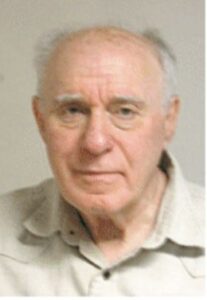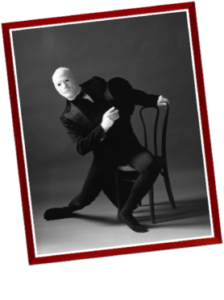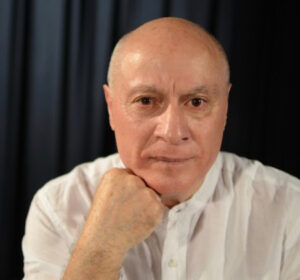
Myron Love
As a performer/teacher/actor/mime artist, Giuseppe Condello is virtually without peer. He has forged a career that has taken him throughout North America and Europe. That includes an invitation to tea with our late Queen Elizabeth at Holyrood Palace in Edinburgh.
And after more than 50 years in the world of the theatre, he is still exploring new forms of creativity.
I first met Giuseppe in 1982 when he and his wife and partner, Kathy, were organizing the world’s first International Corporeal Mime Festival – right here in Winnipeg – in honour of his own mentor, the great Etienne Decroux. I have to say that Giuseppe was – and is – one of the most impressive individuals about whom I have had the pleasure of writing about and getting to know. He has the ability to express himself eloquently with and without words.
I caught up with Giuseppe last month over coffee at Piazza DiNardi during which he filled me in on his early days as well as bringing me up to date on what he has been up to over the past 35 or so years since we last met.
Giuseppe spent his first years in southern Italy in the town of Bovalino Marina on the Ionian coast. The future mime artist was six when he arrived in Winnipeg with his parents, brothers and sister. He recalls that his first exposure to celebrity came through his family’s connections to night club owner Charlie (Carlo) Mazzone who brought the Condello family to Winnipeg.

“My parents worked at Rancho Don Carlos,” Giuseppe says of the popular night spot that Mazzone opened in 1950 and operated for a decade. “As kids, my sister and I would often hang out in the kitchen while the likes of Bob Hope, Louis Armstrong and Nat King Cole would be performing. But it was only years later that we would come to appreciate their celebrity.”
It was a different kind of performer though who inspired Giuseppe to pursue a career in theatre and – specifically – as a mime artist. That performer was the great Charlie Chaplain whom Giuseppe remembers first seeing on the big screen at the neighbourhood Park Theatre when he was 10.
Early in his high school years. Giuseppe enrolled in acting classes at the Manitoba Theatre Centre and soon caught the eye of MTC co-founder and artistic director John Hirsch. Hirsch encouraged the young would-be actor to apply for one of just six openings for males at Montreal’s prestigious National Theatre School of Canada. “I had three wonderful years in Montreal,” he recalls. “After graduation, I began getting roles in places like the Centaur Theatre in Montreal and the Young People’s Theatre in Toronto.”
Giuseppe’s next stop was Stratford, Ontario, where Jean Gascon, the artistic director of the Stratford Festival of Canada from 1967-74, who cast the young actor in several small roles.
“Jean Gascon noticed my talent for subtle physical movement,” Giuseppe recounts. “He was the one who arranged for me to go to Paris to study mime.”
At Stratford, Giuseppe became friendly with the inimitable French mime artist, Marcel Marceau. When the first choice as teacher for Giuseppe didn’t work out, Marceau offered to be his teacher. As it turned out though, Marceau just at that time was booked for a world tour.
Marcel offered to introduce Etienne Decroux, his teacher and the founder of the discipline of corporeal mime, to the young Canadian. Thus, in 1972, Giuseppe and his wife, Kathy, moved to Paris. “After three months, Etienne promoted me to the advanced class,” Giuseppe recounts.
(One of the other students, he notes, was American actress Jessica Lange.)
“I studied with Etienne for two wonderful years,” Giuseppe says. “Friday evenings, we would sit on the floor in his basement while he shared his wisdom with us.”
While, he notes, Decroux wanted him to stay longer – and he wanted to stay – Kathy had already gone back to Stratford and his funds were running low. “It was hard for me to leave,” Giuseppe recalls. “I had tears in my eyes. But, Etienne assured me that I knew the work and that I was ready to go solo.”
After a short time back in Stratford, Giuseppe and Kathy returned to Winnipeg in 1975 where they founded 40 Below Mime (-40° C was the low the day they landed back in Winnipeg) and began to teach as well as perform.
 Giuseppe Condello
Giuseppe Condello
In 1981, the Condellos conceived of a most ambitious project – the world’s first international corporeal mime festival- to be held right here in Winnipeg at the newly-opened Gas Station Theatre in Osborne Village.
While the festival was intended to honour Etienne Decroux, he and his wife were not well enough to attend – but their son, Maximilian, did put in an appearance.
“We invited top artists from around the world,” Giuseppe recalls. “And we treated them to Academy Award level perks such as hotel suites and limo service. On opening night, we put out the red carpet complete with bagpipers to greet our stars. The reception was wonderful.
“We also received international recognition in newspapers, magazines and on television.”
Giuseppe and Kathy made the festival an annual event for the next nine years. “Our last festival was in 1991,” Giuseppe notes. “That was the same year that Etienne died. We were burnt out.”
Throughout that period (the 1980s), Giuseppe traveled widely recruiting artists in his official capacity as a Canadian Department of External affairs ambassador to his festival.
Throughout the ‘90s, the Condello Family (with son, Anthony) moved across Canada. For a time, Giuseppe taught at Bishop’s University in Lennoxville, Quebec. They then moved to Victoria where Kathy retired to devote her time to crafts. As there was little work for Giuseppe, Kathy went back to Winnipeg while Giuseppe moved to Toronto to teach (with frequent trips home). He moved back to Winnipeg in 2013.
Giuseppe’s talent remains in demand. He was, for example, not long ago commissioned by violinist Miyumi Seilor and her Via Salzburg string orchestra to create a performance piece to compliment Stravinsky’s Appolon Musagete.
In recent months, Giuseppe has been experimenting with a new artistic medium. He has been working with filmmaker Daniel Ashton on a two-part documentary with funding for the first documentary provided by the Manitoba Arts Council. The first part, which has been completed, focused on his technique.
The second documentary, he points out, will consist of interviews with international mime artists and actors as well as presenting a history of the development of corporeal mime.
And, in a nice bit of completing a circle of life, the boy from Bovalino Marina was recently profiled on national Italian TV (via zoom) which has led to an invitation for him to return to his hometown to teach corporeal mime to a local theatre group.
“I am looking forward to it,” he says. “We are just trying to get the funding in place.”

